A description of a journey of discovery and explorations in London’s hinterland.
A few months ago I discovered and became an accidental traveller in a new and strange world beneath my feet. My entrance into this new world came about when I started off across London Bridge, over the river Thames towards the city to do some street photography. My eye was caught by an area of foreshore on the north bank exposed as the tidal river retreated towards the estuary and the North Sea beyond.
Descending the steps beside the bridge and walking east I followed a broad flight of steps down to the foreshore in front of Custom House. Within a few feet, I arrived in a different world and the hustle and bustle of the city disappeared.
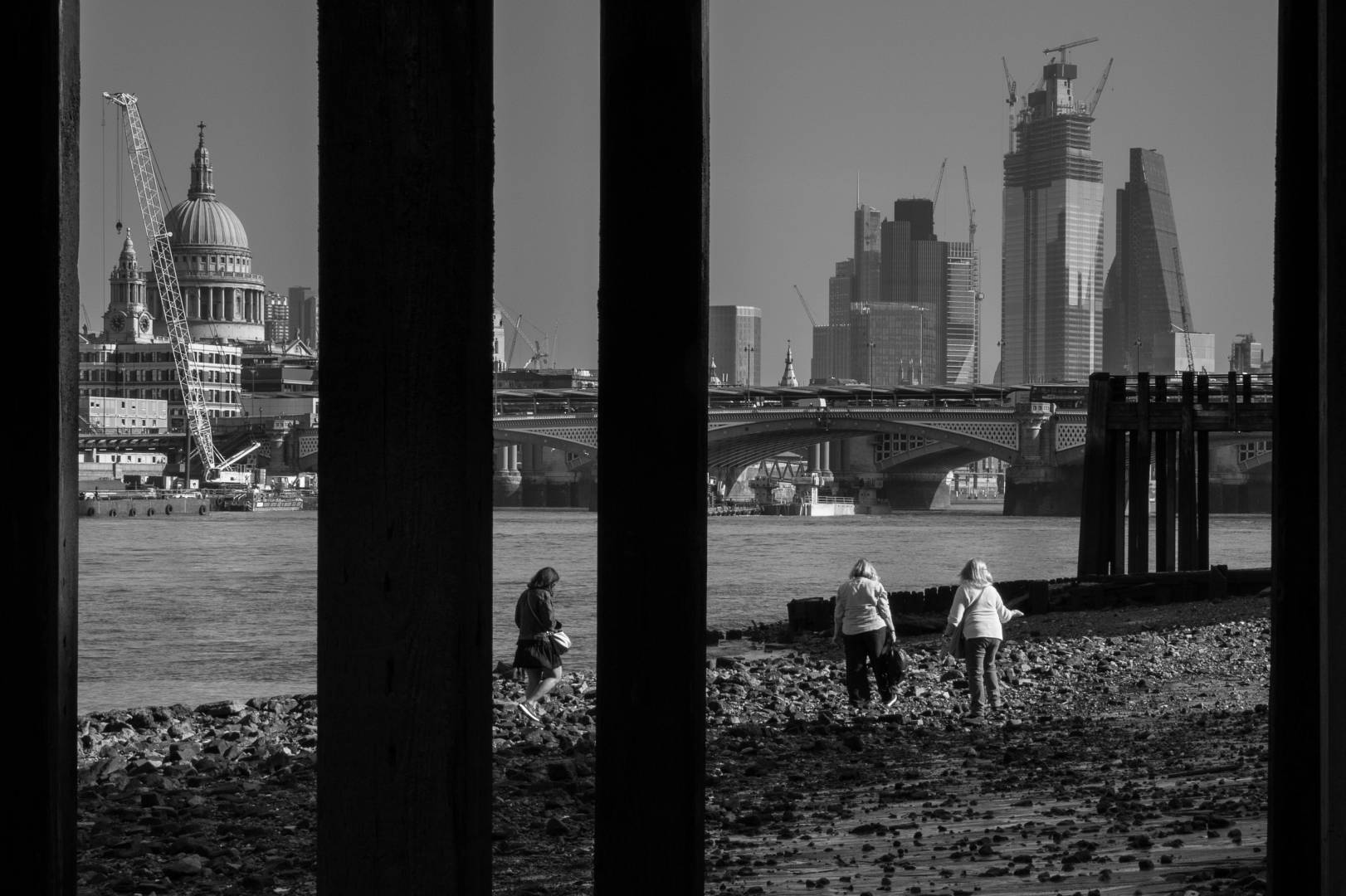
I was immediately enchanted and enthused to explore this place which I describe — taking a little poetic licence — in the sense that it is ‘an area lying beyond what is visible or known’ (Oxford Dictionaries) as London’s hinterland.
Sometimes it is visible, sometimes not, but it is always there with its own residents, rhythms and returning visitors. As I returned to the hinterland, themes developed such as its separation from the city life above, its quietness and peacefulness and the glimpses of history that can be gained from the objects appearing there.
Mudlarking
The sense of otherness was tinged with one of wilderness. The river allows and then denies access and this hinterland is not always a safe place. We visit there as and when we are permitted by the river and we must leave before it catches, captures and holds us. I have read that any wilderness has one of two effects on people; either they are fearful and walk away from it or they are fearful and walk into it to explore. So be it.
While preparing this, I became aware of a book by Lara Maiklem called Mudlarking. Mudlark is the term used to describe “a person who searches the banks of tidal rivers for scrap metal, ropes etc. to sell” (Chambers dictionary). I first heard of it as a BBC Radio 4 Book of the Week and have found it to be a very helpful guide and very descriptive of how I feel about the foreshore. To plan my explorations, I used the website of the River Thames Society for access points in conjunction with a smartphone app for tide tables.
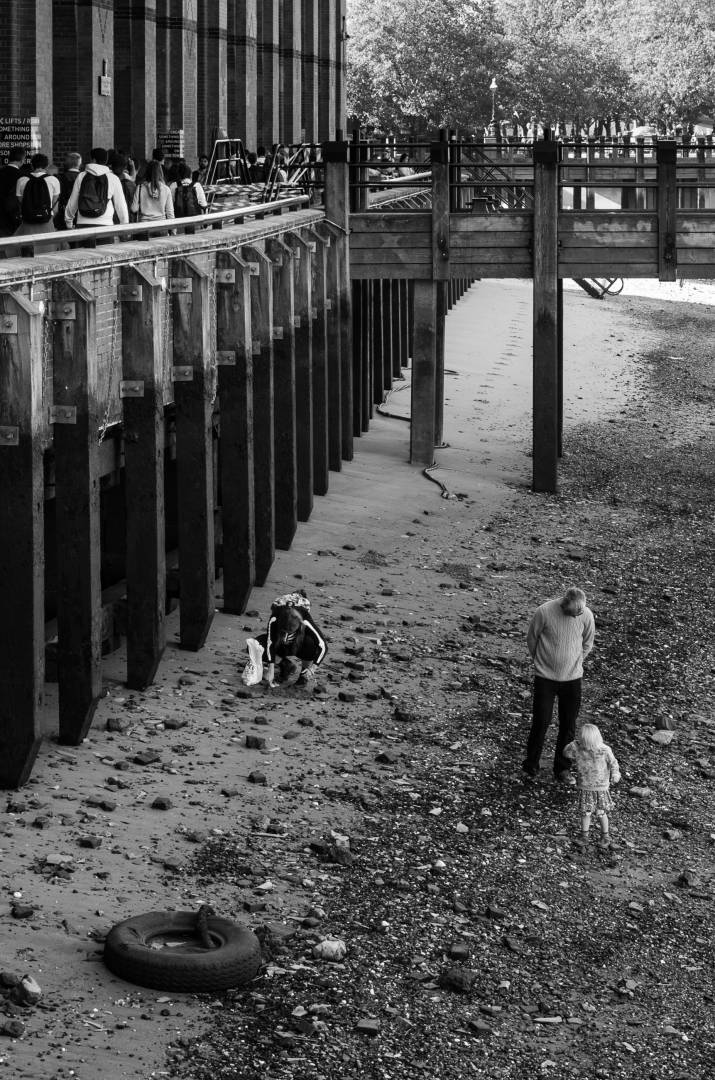
East from Westminster Bridge on the south side of the river the area is known as Bankside. Here you can find the Tate Modern Gallery, housed in the old Bankside Power Station building, and Shakespeare’s Globe Theatre.
Below the embankment wall, a large area of the foreshore is exposed at low tide and mudlarks descend to start their work, picking around for treasures, unobserved by the oblivious crowds passing above them. Others go to explore the foreshore or to have a quiet walk during their lunch breaks and birds find it a safe place to rest.
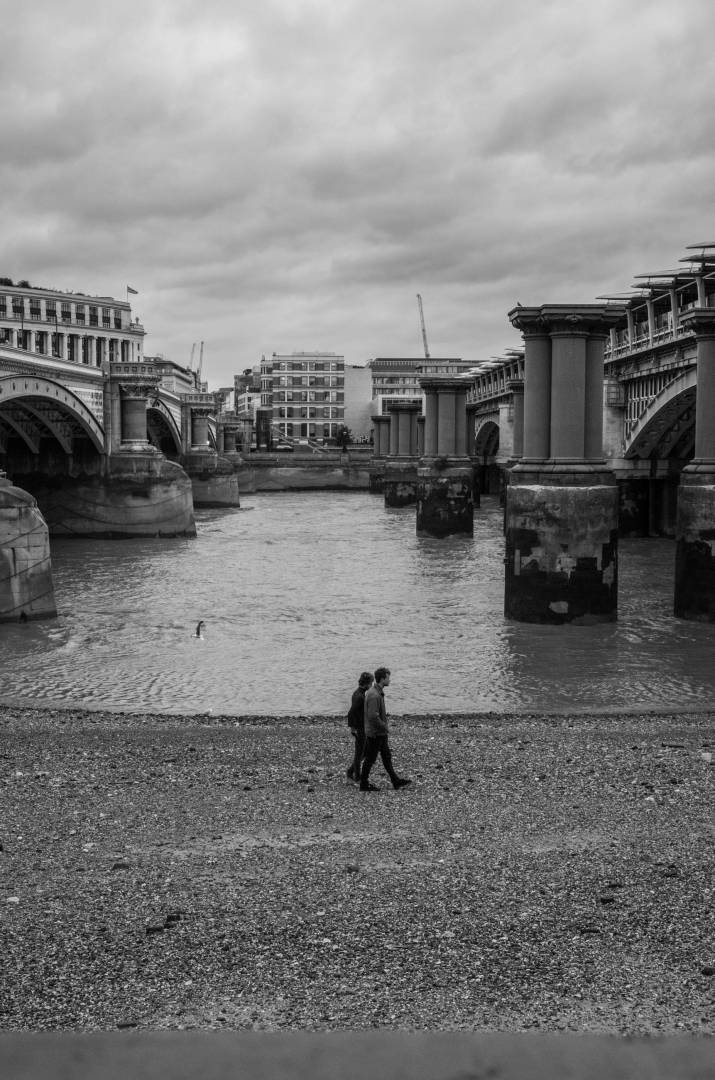
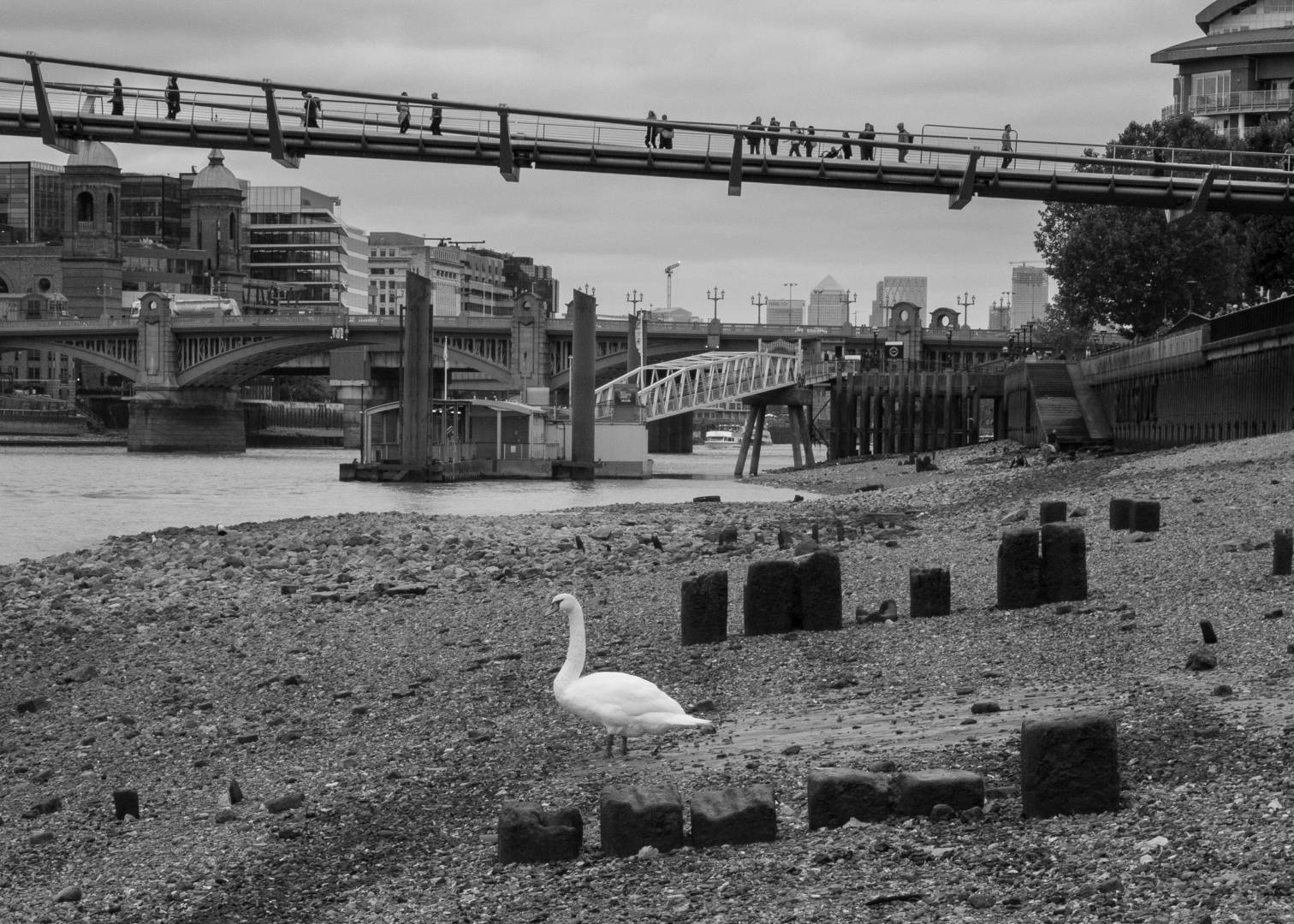
Sense of history
Across the river on the north foreshore east of London Bridge, where I first entered this world, I saw the remains of old barge beds built to provide level platforms on which, in the past, barges could be loaded and unloaded. They gave me a sense of history and I liked their juxtaposition with the warehouses and the Shard building opposite, all symbols of the city’s commercial life through the centuries.
As I tried to frame both the barge beds and the Shard to capture this juxtaposition, a River Police launch passed between them. I later learnt that the oldest element in the photo is the River Police, founded in 1798, which predates both the barge beds and the warehouses opposite. It is now officially known as the Metropolitan Police Marine Policing Unit, having been merged with the Metropolitan Police, or its predecessor, in 1839. Its base is still in Wapping High Street but everyone I know still calls it the River Police.
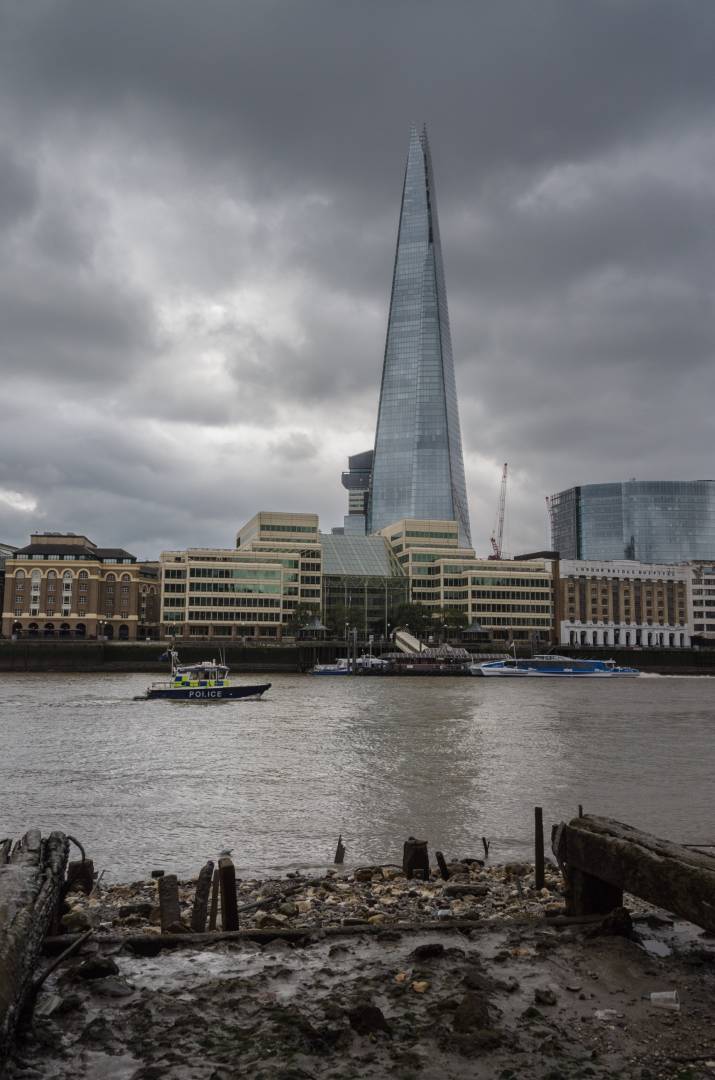
Exploring further east, I found more barge beds, with Tower Bridge behind, and then turned back west towards Westminster, descending to the foreshore whenever possible.
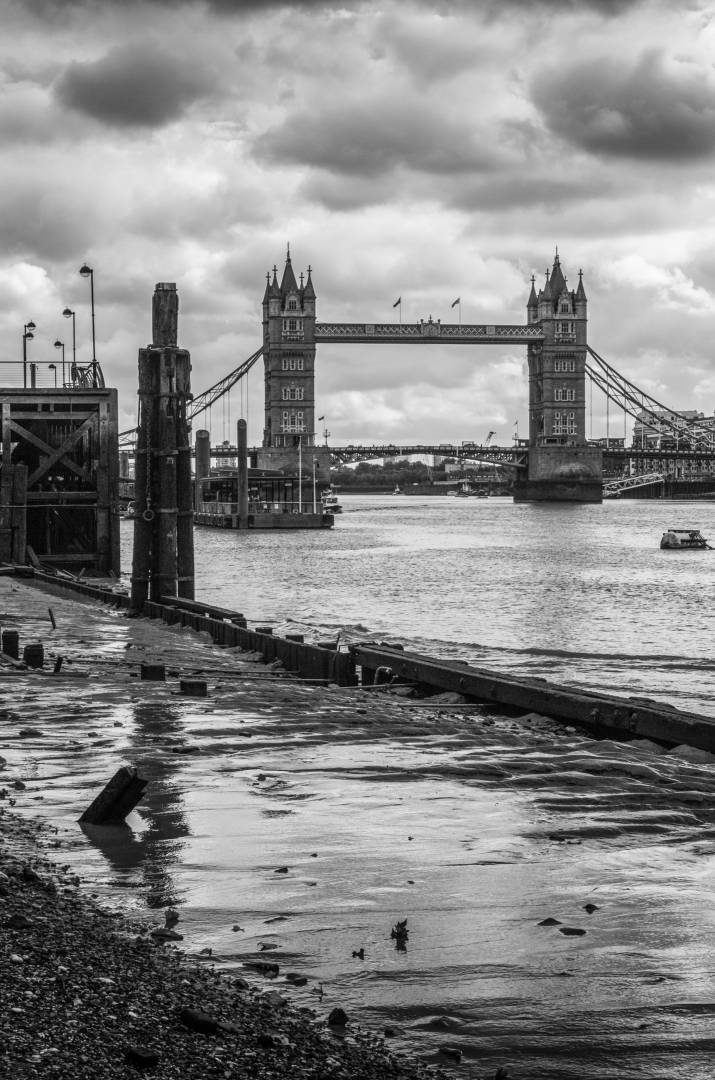
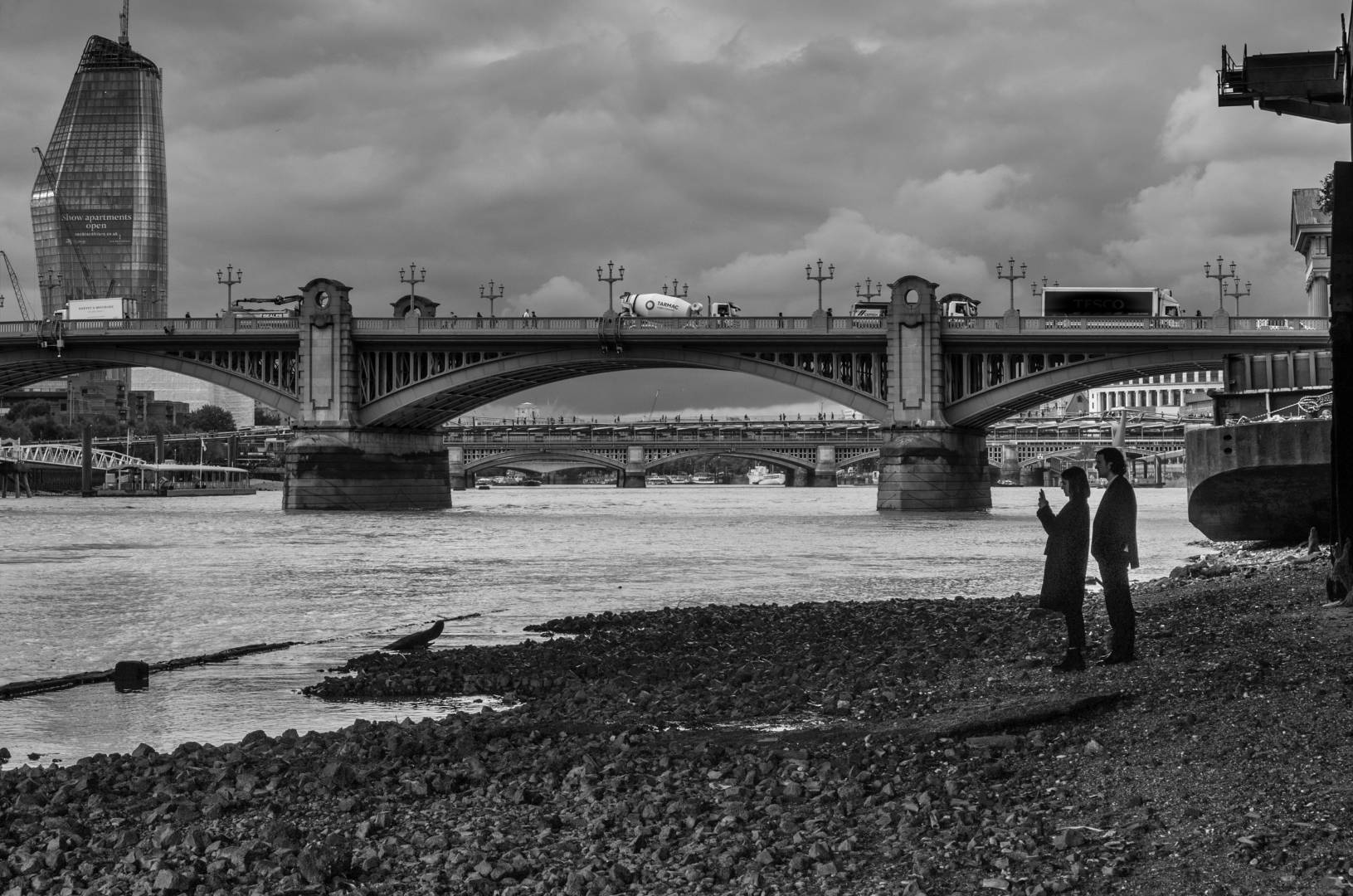
Wapping foreshore
I wanted to explore the north foreshore around Wapping beyond Tower Bridge as I had seen exposed areas from the South Bank and also, to my surprise, on Google Earth. Leaving Tower Bridge, I looked for ways to access the foreshore and between the old buildings, I found atmospheric narrow stairs and alleyways with views to the river beyond.
Lara Maiklem writes in her book Mudlarking that the small causeways from the bank allowed access to the wherries, small boats that, in former times, ferried passengers across the river.
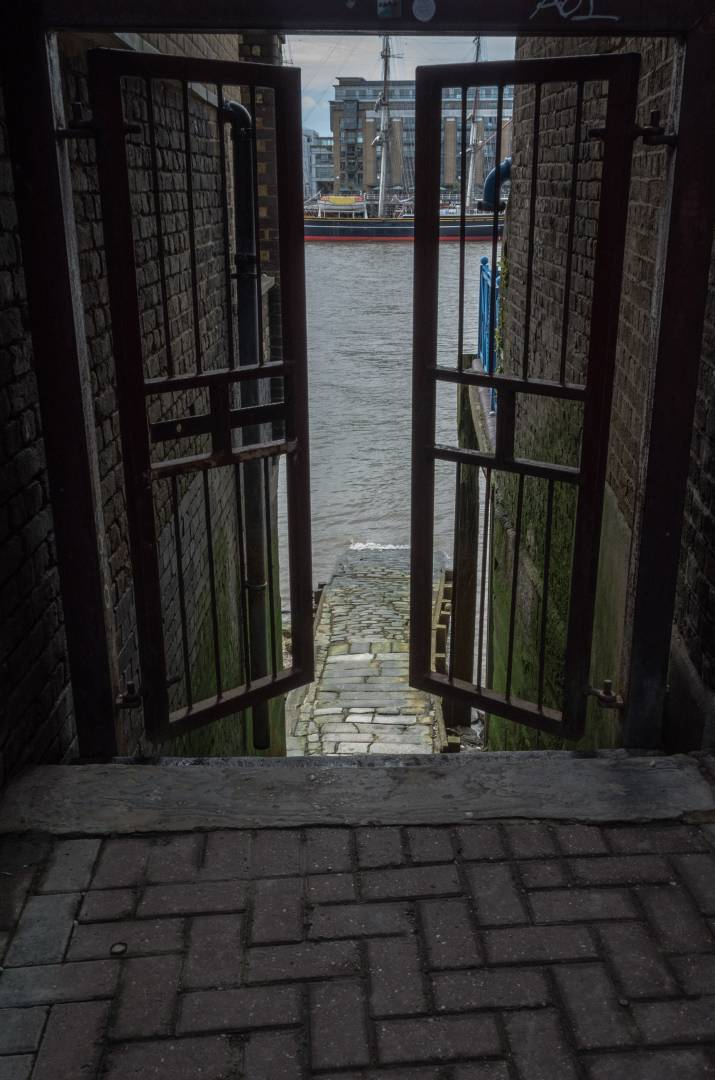
I was struck by Lara Maiklem’s description of this area: “The narrow passageways that survive are cobbled time tunnels, unchanged for centuries; dark, cold and windy, musty and damp with river air, they smell and feel like the past.
In places they lead to equally ancient stairs, rotten wood and stone steps worn by millions of feet into a series of sagging crescents. And with the outside world kept at bay behind the tall brick walls that line the river, I can easily lose myself in another world altogether.”
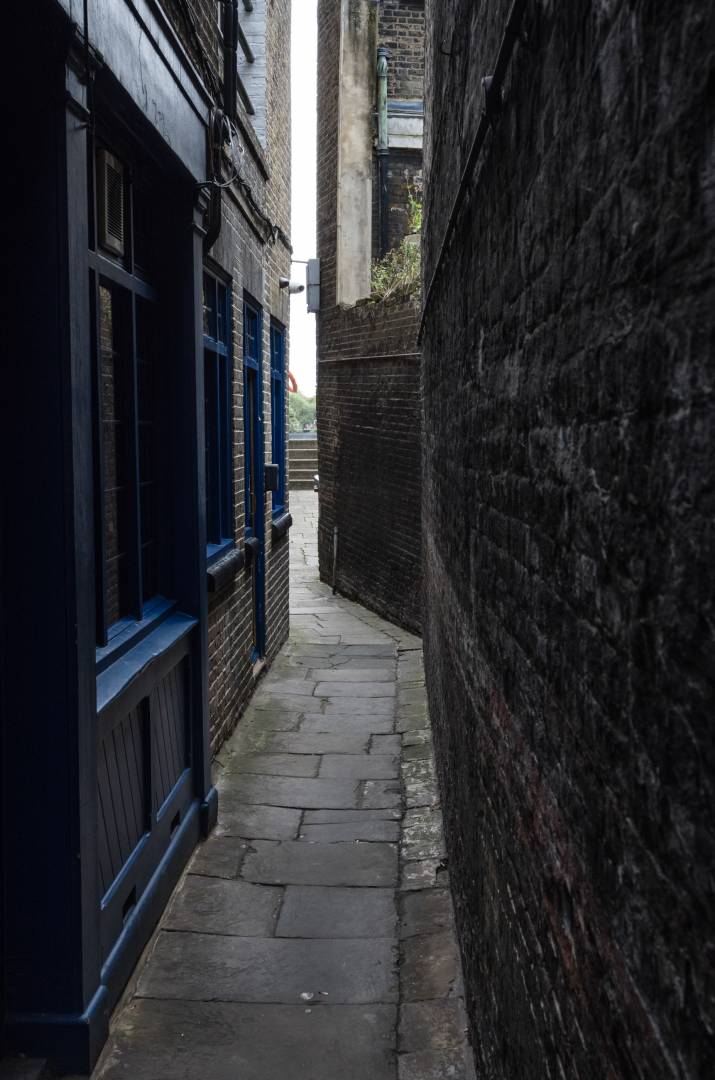
Beside The Town of Ramsgate pub, the narrow alleyway led me to Wapping Old Stairs. Intrigued by the names, I later found the following on the pub’s website:
The reference to Ramsgate became about after the fishermen of Ramsgate who landed their catches at Wapping Old Stairs. They chose to do so as to avoid the river taxes which had been imposed higher up the river close to Billingsgate Fish Market.
Pirate ways
As for the Wapping Old Stairs next door, they also have a bloody history.
“If you visit during low tide, you can still see the post to which condemned pirates were chained, to be left to drown as the tide rose.”
I saw no chained pirates hanging around on the point of being drowned, or the top of the head of an ex-pirate (things aren’t what they used to be), but two men were leaving the place where they had been working, having been driven back by the rising river. I returned down the alleyway, chatting with them and resolved to visit again on another day.
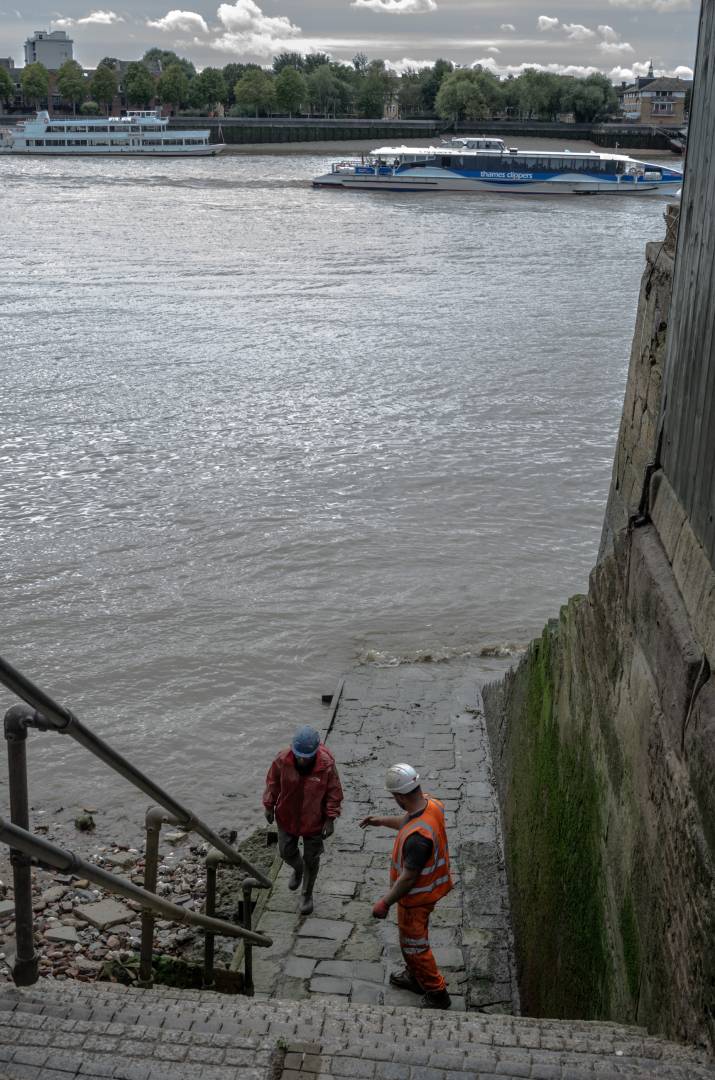
Modern goods, ancient treasures
I returned to the southern foreshore, east of Tower Bridge, on other days and at times when my tide tables application showed convenient low tides. Walking from London Bridge, I passed a construction site of the Thames Tideway sewage project and reached Bermondsey Beach opposite Wapping Old Stairs. It can be seen in the background of the image above. The few visitors allow the local swans to rest briefly on land, preen themselves and, when ready, launch again into the river.
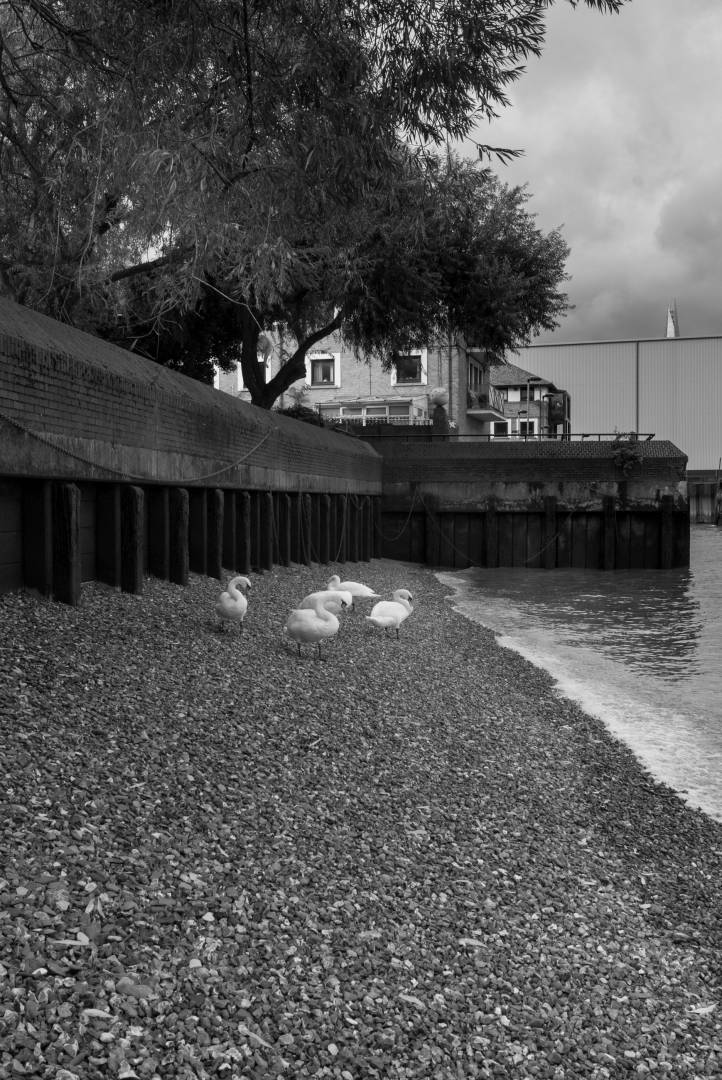
On one visit, I met a mudlark with a metal detector making his way back and forth on the foreshore. I checked that he was happy to be photographed and looked for compositions to try and show how I felt about him working in this other world.
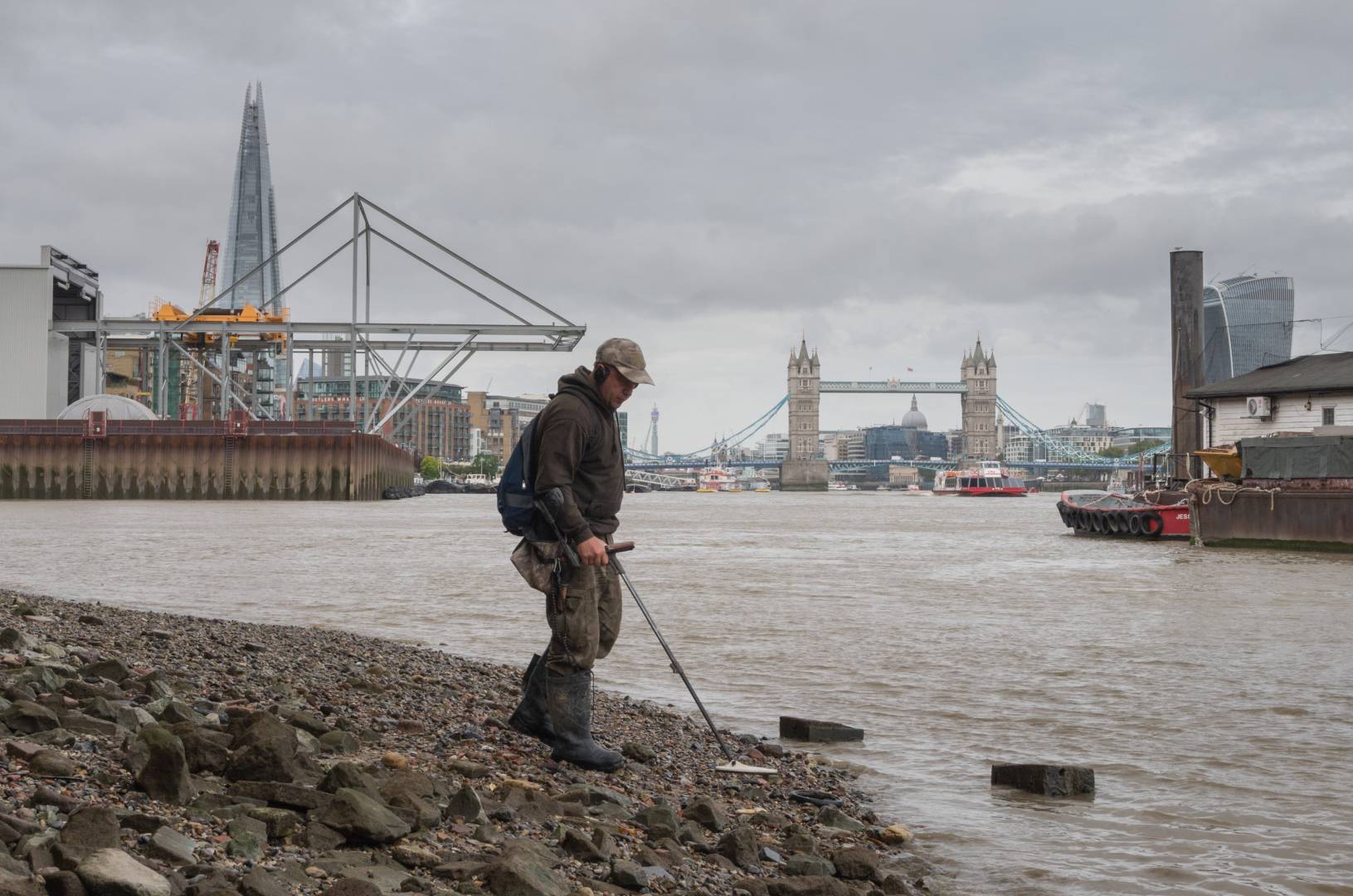
He searched methodically and, when his detector indicated something of interest, he dug carefully to expose it. He told me that he’d previously found a Roman coin and showed me a photo on his phone. The coin is one of only two such found in England. In answer to my question, he said that he was fully licensed for his digging — a requirement now for mudlarks.
As the working world continued above us, with delivery drivers bringing their goods, in the hinterland just below their feet the mudlark collected those goods that were delivered lost or discarded in centuries past.
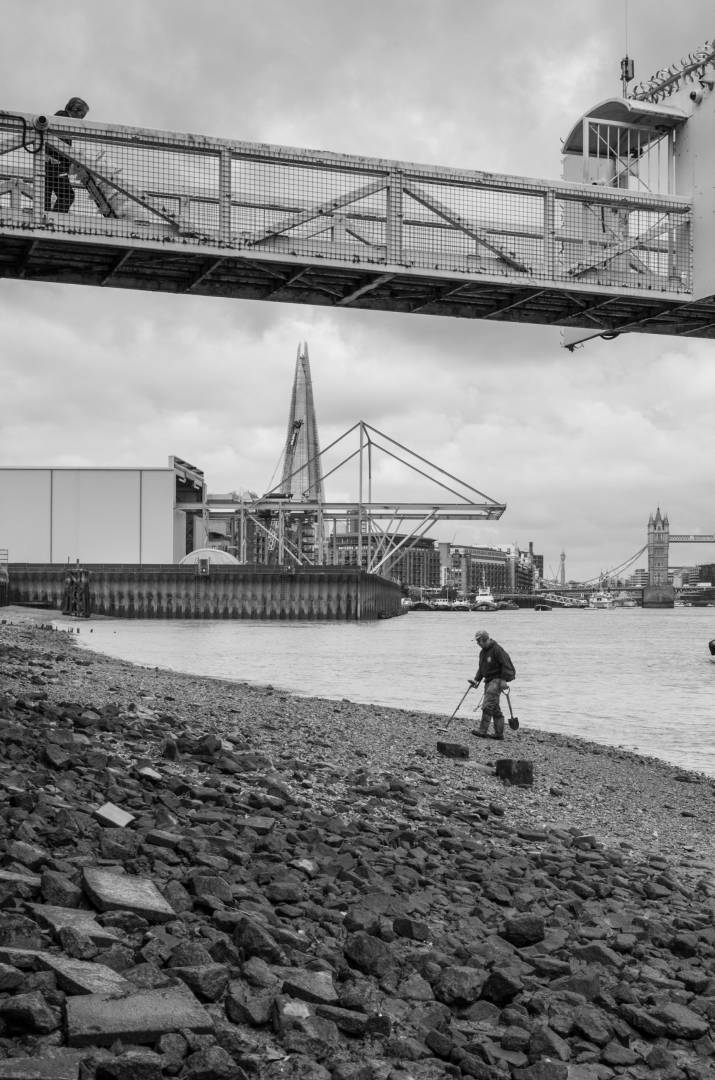
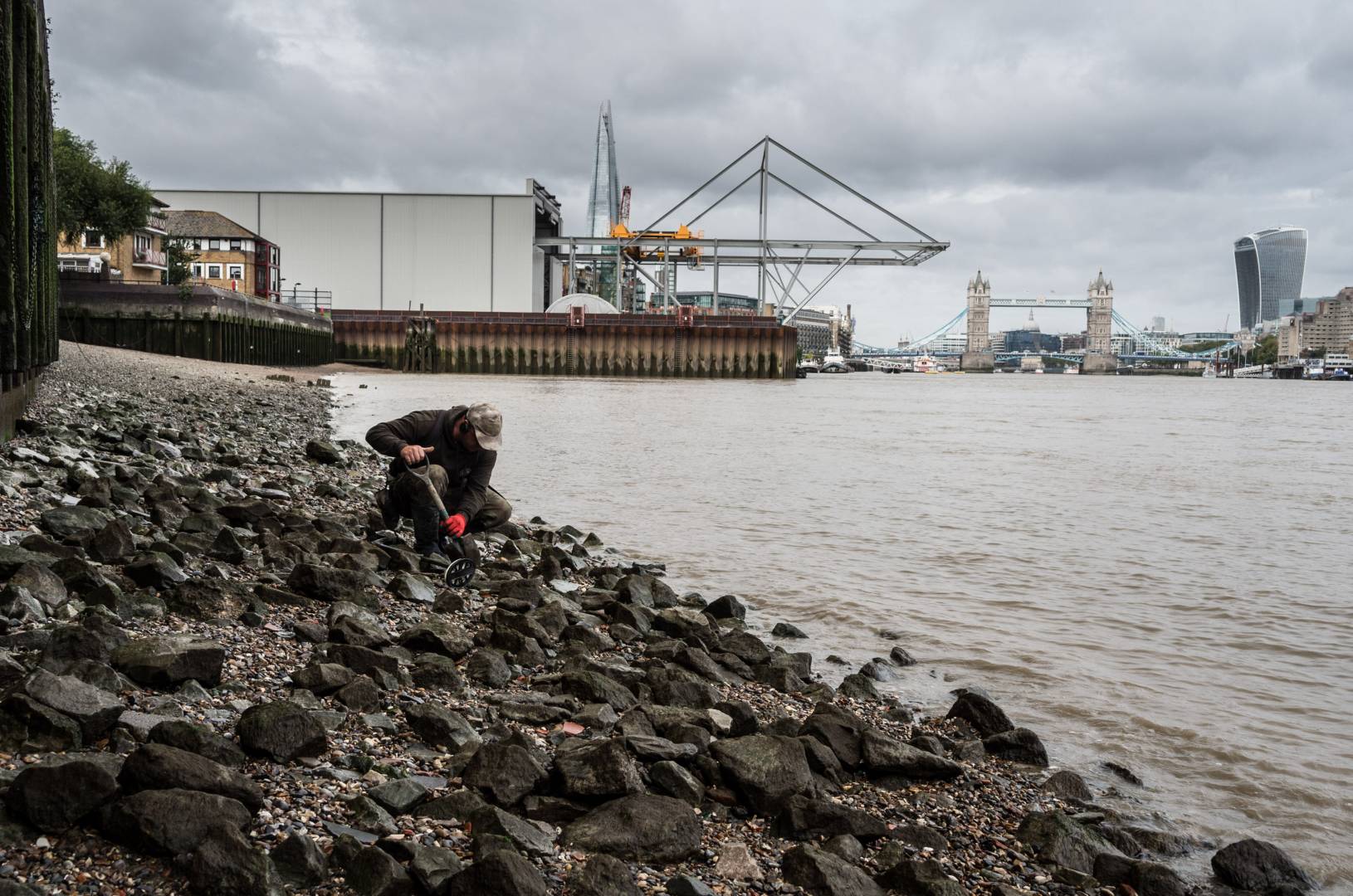
Mayflower ho!
A short distance further east lies the foreshore at Cumberland Wharf in Rotherhithe. This area is said to be the place from where The Mayflower left London for its voyage to North America.
Making my way down the short flight of stairs through the embankment wall to the foreshore, I saw a man walking his dog joined by a young woman using the wall for her morning yoga.
Asking her if I could include her in my photographs she agreed in a North American accent and, far behind her on one of the buildings, the flag of the United States flew. A happy coincidence.
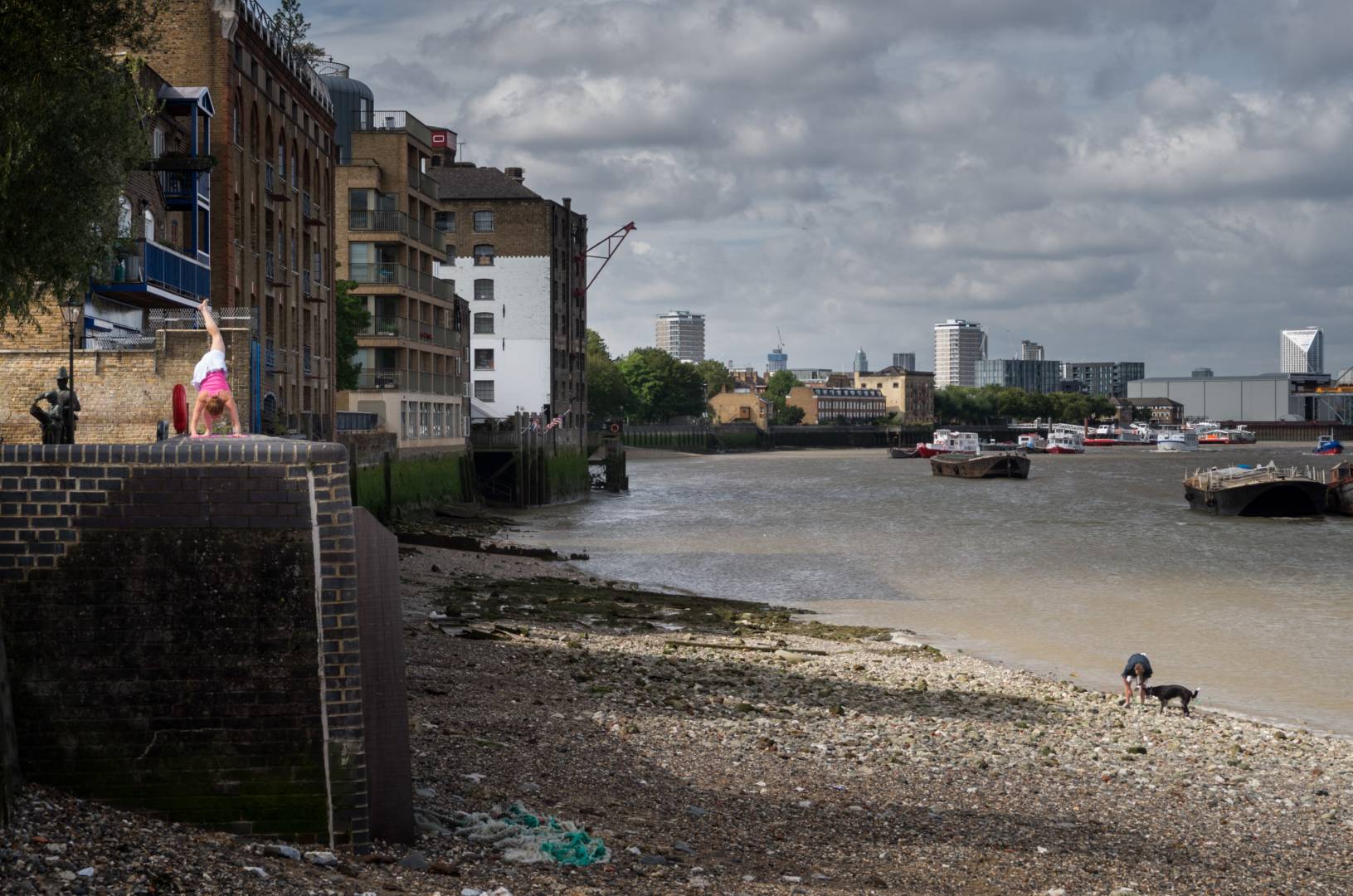
Having walked up and down the foreshore, I stopped to eat my lunch on the steps and enjoyed seeing the traffic on the river passing the boats moored on the foreshore. The cruise ship was turned by the tugs just east of Rotherhithe, presumably because the river is wide enough there, before being pulled backwards into the Pool of London.
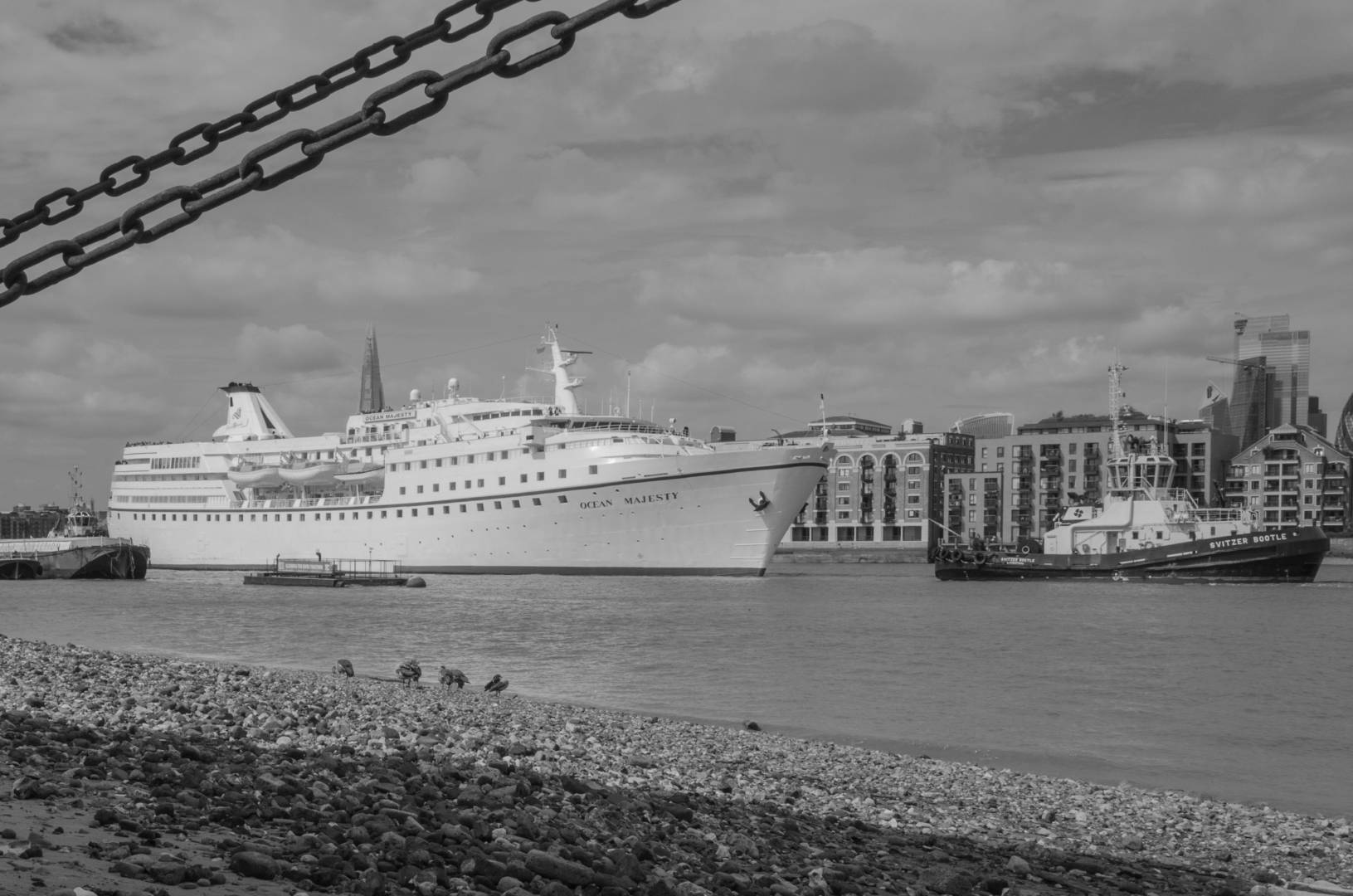
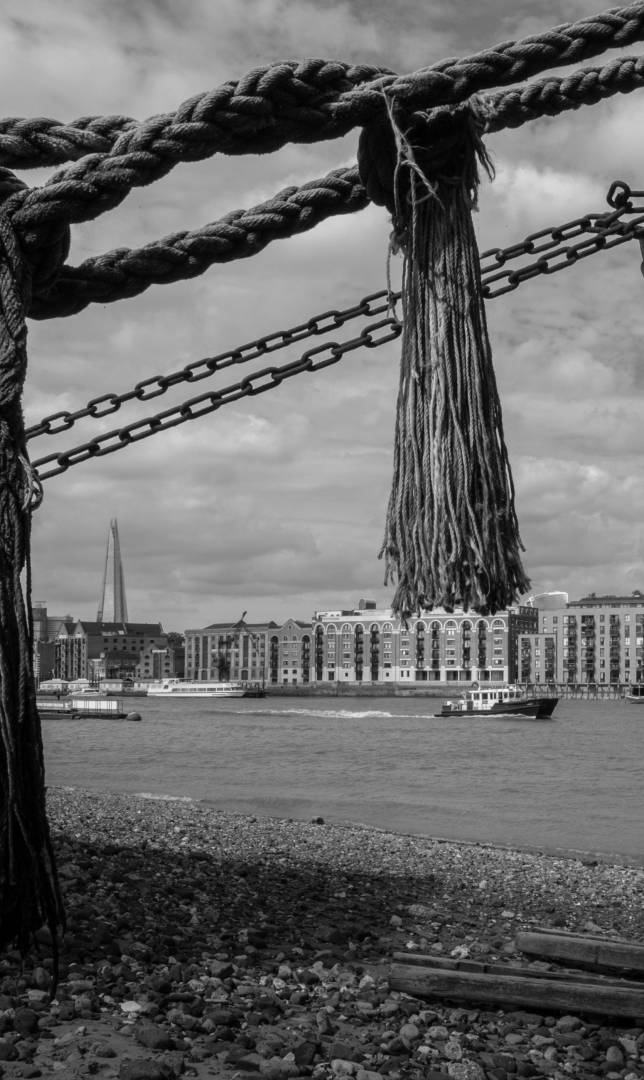
Risk-taker
My most recent visit to Rotherhithe was as the tide was coming in and I made sure I was close to the steps as the water approached. I had planned to reach the foreshore when the river was lower but two trees falling on railway lines to the south of London had thrown the rail network into chaos and delayed my arrival.
As luck would have it, and as I was leaving the foreshore, a young man, sounding obsessed with finding a can he had dropped from the path above, ran past me. Unable to reach the can, he changed his mind and threw stones into the river oblivious of the rising water cutting off his escape. Finally responding to the increasingly desperate entreaties of his friends he climbed a ladder and pulled himself over the wall to escape.
Far from safety, easy to go there but hard to get back Oblivious to being cut off A handy means of escape
Having had enough amusement for the day and forced by the river to abandon the foreshore — tide and time wait for no man (must patent that one) — I retired to The Angel pub in Rotherhithe for a coffee. It’s a Sam Smith pub, by the way.
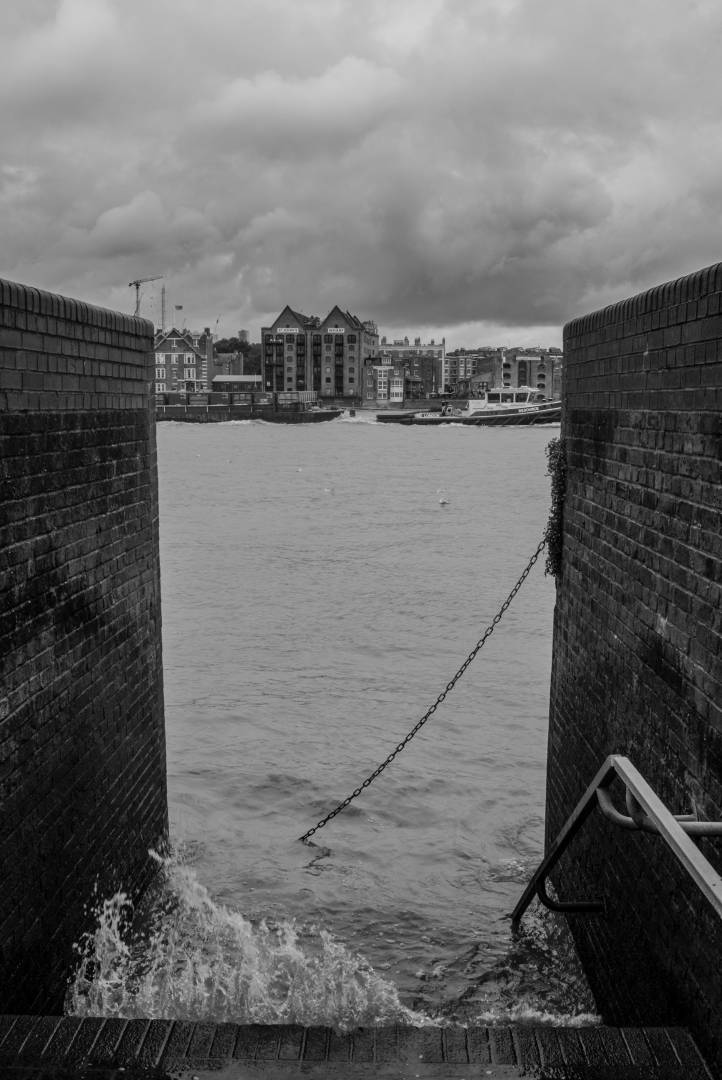
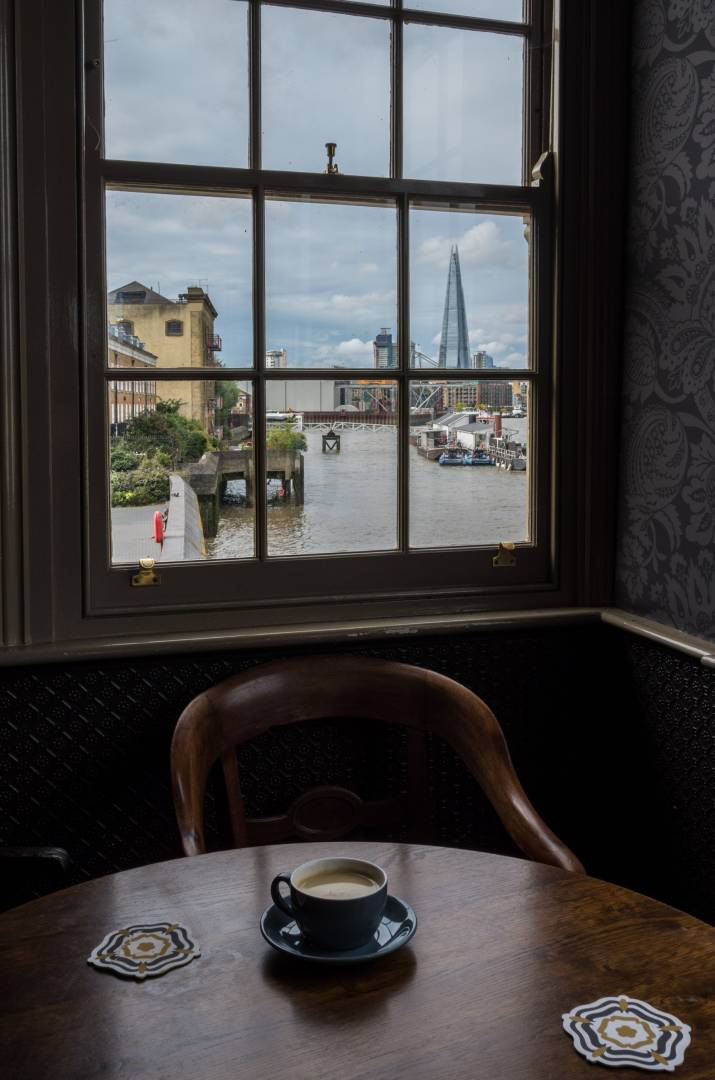
I plan to return to this hinterland whenever time and tide allow. It will continue to be a place where I can briefly escape from the world of the city above. I look forward to seeing the birds resting, the river traffic passing by and the mudlarks searching for those treasures that will so evocatively provide a bridge between London city and its hinterland.

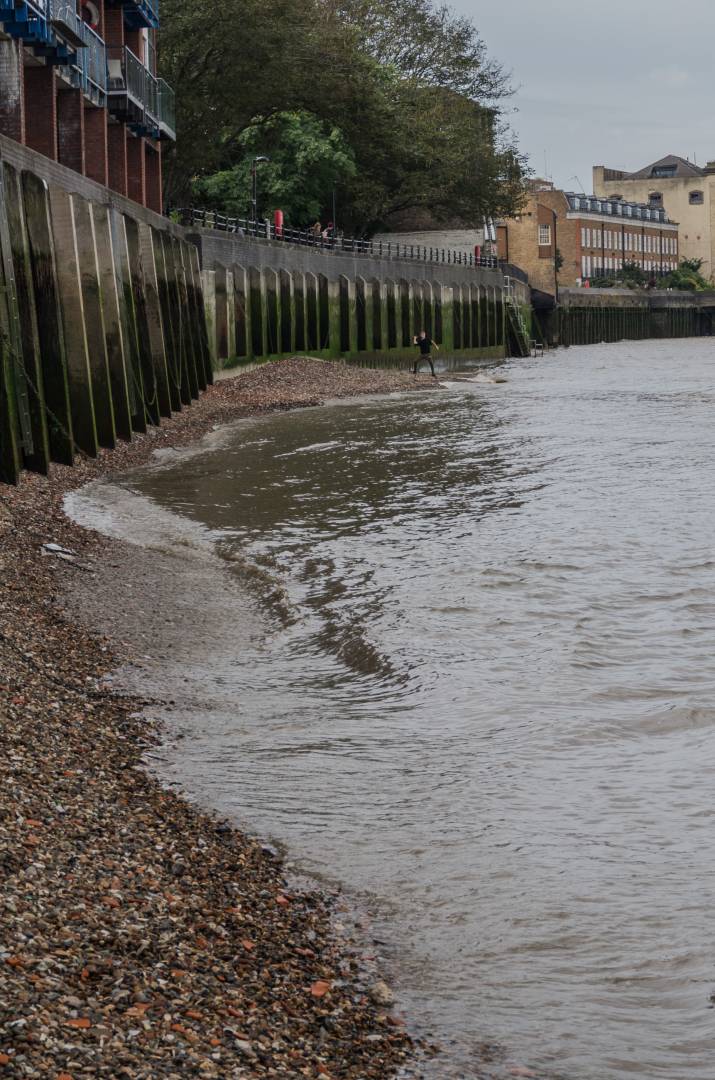
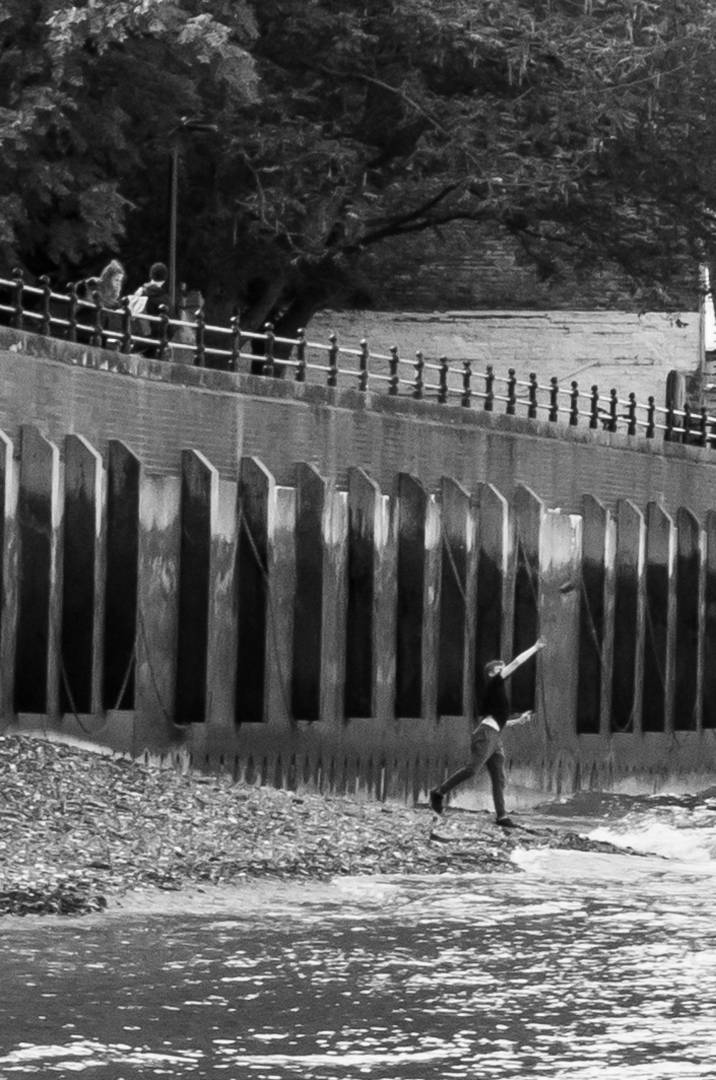
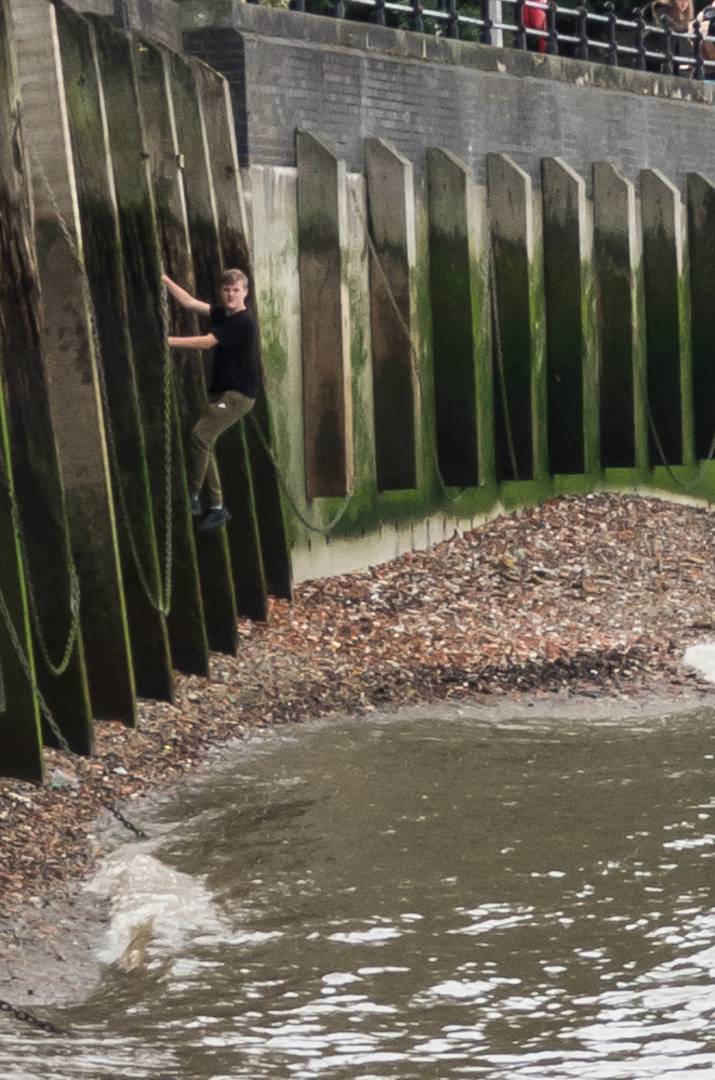
I’ve walked these foreshore areas for years and I agree with you, they can be very enchanting. It’s useful to have a tide app on your smartphone so you know the times which are good to visit and how long you have to meander. Tides can come in quickly. There are several apps for iPhone on the App Store and I imagine the same is true for the Play Store for Android. The iPhone app I liked the best is called TidePoint. These apps cover the tides across the UK, I found TidePoint the best for the areas you describe above.
Great article Kevin and the accompanying images are superb. I go to London from time to time to do some street photography but your documentary will certainly inspire me to have a look at the ‘hinterland’ you describe.
You mention The Angel as being a Sam Smith’s pub, one of my favourite beers; my stepsister running the brewery pub in Tadcaster some years ago, and so this would be reason enough to make the trip.
Best regards, Tom
Tom, thanks for this. To be frank I was a bit surprised that Sam Smith had travelled so far South particularly crossing the river. Perhaps it’s the most southern outpost.
Thanks Dave, it’s a world that one can experience almost immediately on entering so if the river is low it’s worth a visit even for a few minutes.
I have often walked the Southbank and looked down a small beached area that looked totally out of place, but I have never thought about walking down and taking a closer look. Well perhaps, that could be driven by always being in a rush when I pass through the city and walk around the area between Westminster and St Pauls.
This is a great article, and opened a whole new world of exploration and potential. Thank you for sharing both the images and journey. I am now more curious as to where you will pop up in the future.
Dave
Interesting and enjoyable images Kevin. Subject matter and perspective.
The last one is my favourite.
(….but I do know that your write up will result in me being castigated once again by Mr X1 at coffee next Tuesday, for selling my XV a couple of years ago. Sigh!).
Hi Wayne, Thanks, the chair in the last photo has your name on it waiting for your next trip to London.
I love seeing photos like this where the camera has been used to explore and tell a story, especially of a part of history or life that often goes un-noticed. The other nice thing is that you used the camera that isn’t the latest and greatest to make interesting images instead of showing what megapixels and image stabilizers can do or just how good a 47MP sensor is ( not that the X has those ). People seem to waste a lot of time doing this these days! Great work and thanks for sharing.
Stephen, Thanks, the X Vario is ideal for this sort of photography.
I have enjoyed walking along the river finding old clay pipes, kayaking from Rotherhithe to Vauxhall, commuter boating from Chelsea to Blackfrairs, and walked home along the river many times. These photographs capture all of that in with glory that even surpasses my romantic minds eye of memories there. Congratulations on a fantastic piece, Kevin.
Thanks Dan, I’m glad it brought back happy memories.
Black / White, color great atmosphere for pics, with a very interesting text, what more can we want! I wonder how much they charge mudlarks for license, that gateway to the hinterland should be in a Hairy Potter flick. You and the Xvario are a team.
John, Thanks for this. I checked on the website of the Port of London Authority who manage the foreshore. There are a number of regulations about accessing it which must be complied with. The standard adult permit, which allows searching to a depth of 7.5cm, costs £85 for three years. People who want to ‘dig deeper’ have to go through a more convoluted process to obtain the relevant permit.
A joy to read your text, a delight to enjoy your images.Thank you, Kevin, for a thoroughly atmospheric experience. I am reminded of reading Peter Ackroyd on London and the Thames or some passages of Dickens similarly though neither deployed their Leica X Varios half as effectively as you have! In my view, you have opened up to us an aspect of the enduring Thames not often seen or appreciated. I very much admire this article and pictures. Hoorah!
Thank you David, I appreciate your kind comments.
Really lovely pics – with a great sense of the spatial isolation and aura of the place. I remember as a child being taken down the river eating periwinkles, stopping off at various muddy places to look for razor shells, and ending up on the mud-flats at Southend, when digging for shellfish was a muddy but delightful sport. And then the smell of garlic as mother steamed them when we got home. Thanks for these memories – and it also demonstrates that no-one really needs anything more than the great lamented and overlooked X-Vario.
Hi Tony, I’m glad the photos captured my feelings about the place and brought back those memories for you. I can smell the garlic!
I thoroughly enjoyable article and great photographs, one wonders how many other gems hidden in full view are waiting to be discovered?
David B’s memory of the coaster “Catharina W” sent my memory spinning back to September 1959, when as a trainee shipbroker, the first vessel I boarded as a water-clerk bore the same name. She was flying the Dutch flag and was discharging a cargo of Scandinavian timber at the Exeter City Basin. Like the majority of vessels trading to Exeter her cargo capacity was in the region if 250/300 tons.
I wonder if we it is the same ship?
Thanks Alan, it would certainly be a a coincidence.
Alan,
I knew and worked on the ‘Catharina W’ in the early seventies (1972?) after she’d been sawn in half (!) and another thirty foot had been added to her, so she ended up at 150′, I think.
She was then owned by Dennis Cox – her skipper – but I can’t remember the tonnage; I thought it was about 150-200 tons. I now see on the “coasters-remembered” website (which I didn’t know existed until I just looked online for ‘Catharina W’) that she’s listed as:
CATHARINA W,1949, – ,NLD Delfzyl. ex MEEUW
River Thames,19/5/1968.
Subsequent History: 55 CATHARINA W – 77 JENNIFER B
..but no further details. So she was, as you said, originally a Dutch coaster – weren’t most of them? – and I think she had a Bolinders (single cylinder?) engine. Oh and, good grief, there are two pictures of her on that website ..and one looks like it was taken on the Thames!
(Bit of a detour here, but I’ll try and link it back to Kevin’s photos: in the early 1970s there seemed to be so many collisions in the Channel – nowadays there’s a one-way system; upstream on the French side, downstream on the English side – and I was between jobs, and a friend – Ken Gladstone – said I should ask at Taylor’s Wharf at the ‘London Apprentice’ at Isleworth to see if any skippers there were taking on crew. (Well, blow me down if there ain’t a photo of coasters at Taylor’s Wharf (!) on – so I’ve just discovered – Bob Gibbs’ website ..I won’t put a link in here (Google is your friend) as I wouldn’t want people to jump out of MacFilos and out of Kevin’s story.)
There was a man on the outside coaster (up to four at a time moored at Taylor’s) so I called out and asked him. He said “Can you keep watch?” ..”Can I keep watch! Ha!” ..”Can you read a chart?” “Can I read a chart! Ha!” ..”Well the mate’s just jumped ship and we’re sailing in two hours, you’re now the mate”.
I dashed home to get some warm clothes, dashed back to the ship just as she was being cast off, I hopped on board, Dennis took her down the river to Wapping – with a 2 hour pause on Tough & Henderson’s barges at Brentford to wait for the tide to come down – just scraped under Hammersmith Bridge with three inches to spare, and then at Wapping he said “See you in Flushing, good night!” and went down to his cabin to sleep! I was now in charge of this however-many-ton coaster, churning down the river at 12 or 15(?) knots laden with a cargo of lamp-black(?) [soot?] aiming for Antwerp to be turned into printers’ ink. No wonder there were dozens of collisions out there! ..I’d just been hired on the strength of two questions: can you keep watch, and can you read a chart!
Meanwhile, back to Kevin’s pictures..)
I’m so please to see barges, ‘lighters’, in Kevin’s photo “Man, dog and yoga. The inquisitive dog pose?”, as in the 1960s and 70s there were still so many working lighters and tugs on the Thames ..now there are next to none. The traffic has died down – the docks are no longer in use except for pleasure boats like our own – and the river’s no longer the bustling Queen’s Highway which it was.
But on the other hand, there’s peace and quiet along the foreshore, so gloriously epitomised by Kevin’s “Swans resting at Bermondsey”. Thanks, Kevin.
You’re very welcome. Fast forward a few years and you’d have found me behind the bar at The London Apprentice after a particularly difficult meeting with the assistant bank manager, following an expensive car repair and unwise skiing holiday, which in summary went (Him)”financial issues can be a big worry” “so will you extend my overdraft then?” “No”. Great. Although we could help ourselves to the salad bar.
Ha ha ha ha ha! (..No; I mean sorry about your then financial circumstances!..)
Many’s the time I’ve been chipping away at a boat on the beach – we-ell, gravel – against the wall at the London Apprentice. (But many years ago.)
When I went to Cornwall in 1967, I used to walk through London Apprentice, which is a little village (with just a few houses) between Mevagissey and St Austell, when I’d walk the seven miles there and seven miles back (sometimes through the foot-&-mouth wellie-wash and tyre wash) to the pictures, I mean the cinema, on a Saturday night. There were glow-worms on the hedgerows beside the road, and the white river tumbling down from the china clay heaps above St Austell to the sea at Pentewan ..where coasters – yes, like the ones which used to trade on the Thames – waited to take the clay away to distant potteries. (Though I learned, many years later, from a talk at the Natural History Museum, that most of the Cornish-mined china clay has actually passed right through us; it’s mostly used to bulk out, and turn into tablets, aspirin and paracetamol!)
Sorry ..where was I..? Ah; London Apprentice, on the Thames! I seem to remember that there’s a high tide mark on the church facing the London Apprentice – like on or near the riverside church by the Barmy Arms at Twickenham – showing how high the tide rose on some fateful day in 1774 ..and again, I think, in 1928. (I’ve just found a website all about those floods at 20thebarons ..which sounds like the address of Twickenham Film Studios.)
We’ll have to meet up at the London Apprentice one day, Kevin ..perhaps along with Mike, who doesn’t live too far away, and close by the noble River Thames to swap a few stories about the river..
Excellent documentary which could be expanded into a book. Old X-Vario cameras never die … they continue to inspire and enable wonderful photo-essays.
Thanks Dunk, you give me food for thought.
I’m not bothered if they are jpgs or raw files – this is a fine piece of documentary photography and it also brought back so many childhood memories: thank you for sharing.
Philip
Philip, I think you should invite Kevin to join the TLS!
I need to give a ‘shout out’ to Mike for his skilful editing!
Thank you Philip, I’m pleased you enjoyed it.
hi Kevin, great pictures and a great text. I love the way you intertwine pictures and narrative. some great shots from your X vario. Like John, I wonder if you shoot jpegs or raw for the series. Thanks for sharing
Hi Jean, Thanks, much appreciated. I’ve tried to sum up my thoughts on RAW and JPEGS in my reply to John above.
Hi Kevin, a really good article about getting off the beaten path to find great images. Far too often I take the familiar path but when I venture onto side streets I often get my best images.
My favourite image is the final image. Thanks!
Thanks Brian, I’m glad you liked it.
Just as a matter of interest: are the B&W pictures OOC or pp from RAW? “Evocative” (David B.) is certainly the word – and some fascinating angles. And incidentally, a lovely camera to work with, don’t you find?
Thank you John, the pictures are all processed from RAW. I like the way the Leica software renders contrast in B&W especially in the X1 which I have found impossible to replicate in practice. The RAW file in the X Vario holds a surprising amount of detail in the highlights and shadows which the JPEGS lose. I am often pleasantly surprised with the latitude in the files. I also like to emphasise a moodiness or a particular detail in an image. The X Vario is certainly an excellent, if (ironically) specialised, tool.
Well, having lived on the river for twenty-odd years (..and twenty odd years!..) but not now, all this brings back terrific memories of these stretches of the river. [I once had a job as mate on a coaster, going down the river from Isleworth and across to Antwerp in Belgium, and this section, or “reach”, where you show the cruise ship was where I took over from the skipper, and took the ‘Catharina W’ downstream (..in the pitch dark night..) and across to Flushing, in the Netherlands.]
We had our most recent boat moored in South Dock Marina, close by Rotherhithe, till we took her down to Ramsgate to moor her there instead – rather than take nine hours going down the river (..and nine hours back..) when we wanted to get to the Channel and across to France.
You should sent these, especially “Using a modern metal detector to search for ancient treasures”, to the London Tourist Board for them to use in their brochures, Kevin!
(After ‘The Town of Ramsgate’, you should pop down to ‘The Prospect of Whitby’, and – a bit further down – ‘The Grapes’ pub ..now owned (..whoops; leased..) by Whatsisname the wizard of Middle Earth, and Sean Mathias the theatre director, with Evgeny Lebedev (the owner of the London ‘Evening Standard’ newspaper).
And even further down still, the foreshore of Greenwich, in front of the old Royal Naval College, is well worth a scrabble around on.
Terrifically evocative pictures ..makes me want to get me wellies on and go down mudlarking myself!
Thanks David, I was born in a hospital beside the Thames at Hampton Court and some of my earliest memories are of being beside the river so it has always had an importance for me. Your description of being given a weighty responsibility in a difficult environment remains with me.
Kevin, what an historically inspiring story and a fine example of an interesting project. Also some very fine pictures. By the way, Wherries were coastal freighters, powered by sail, which plied routes from London to the ports in East Anglia. A few have survived and can be found in the area.
Can you now claim to be photographic mudlark? 😁
Thanks David, I like the analogy of the photographic mudlark – there are many similarities!